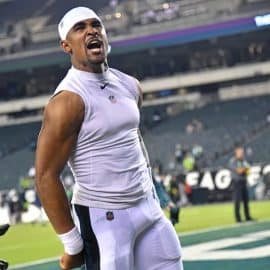 Every year as the NFL Draft rolls around, analysts and draftniks debate the value of players and positions. They always inform the viewers that the majority of starting quarterbacks are taken in the first round, that linebackers usually fall into the second and that value at the running back position can be found late in the draft.
Every year as the NFL Draft rolls around, analysts and draftniks debate the value of players and positions. They always inform the viewers that the majority of starting quarterbacks are taken in the first round, that linebackers usually fall into the second and that value at the running back position can be found late in the draft.
Well, these analysts are wrong.
How can they be wrong when NFL teams seem to agree? Over the last eleven drafts, 247 running backs have been selected. 158 of them were taken in the last four rounds of the draft. That means 64% of all running backs drafted in the last decade have had their name called on the last day of the draft, as teams mine for the next star talent.
Only, these teams aren’t likely to find a starting running back after the first two rounds.
Initial memory may suggest otherwise. Mike Shannahan made a career out of drafting running backs in the late rounds. Remember Terrell Davis? How about Olandis Gary? Even Michael Turner was a 5th round pick.
But the truth of the matter is, these are the exception rather than the rule.
Since 2000, there are fifty-eight running backs that have been starters for multiple seasons. By this I mean that they were either the featured back or an integral part of a committee (Shonn Greene, Justin Forsett, Jerious Norwood, etc.) This obviously discounts any 2010 draftees since they’ve only played one season. But even then, James Starks (drafted in the 6th round) seems to be the only player with a legitimate chance to earn a starting job.
Of those fifty-eight running backs who were featured backs, twenty-eight were drafted in the first round and another eleven were taken in the second. That means that thirty-nine of the fifty-eight running backs who have started for multiple seasons over the last decade were picked within the first two rounds. That’s 67%; a rather surprising number.
While NFL teams keep drafting running backs late, hoping to hit a homerun, most of them are only picking up roster fodder. Of the 158 running backs taken in the last four rounds since 2000, only twelve of them have become multiple year starters, and seven of those were taken in the fourth round, still considered to be the middle rounds.

Another 38 running backs have been taken in the 6th round the last eleven years and only one, Chester Taylor (drafted in 2002), has spent multiple seasons as a starter. Michael Turner may have become an elite runner after being drafted in the 5th round, but Tim Hightower (drafted in 2008) is the only other 5th round running back to join him in starting for multiple seasons.
So, what does all this information mean? It means that while talented running backs have been known to rise out of late round picks, just like quarterbacks, those examples are few and far between. Every Michael Turner and Ahmad Bradshaw should be looked at more like Matt Schaub and Tom Brady that analysts let viewers believe.
If you want your best chance to draft a running back with consistent talent, you better take him in the first two rounds. After that, you’re drafting on a wish and a prayer.
Add The Sports Daily to your Google News Feed!






